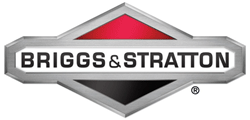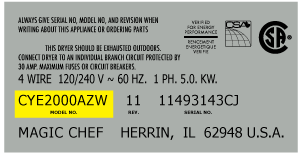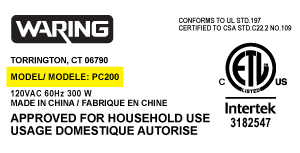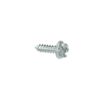11027112600 Kenmore Washer - Instructions
Keep searches simple. Use keywords, e.g. "leaking", "pump", "broken" or "fit".
broken pump and burned out motor
The repair itself was very simply, probably largely due to the design of the machine which made getting to, and replacing the two faulty parts a cinch. Just unscrew the two screws on the motor brackets which hold the motor down, and remove the brackets. Then remove the two smaller brackets which hold the pump to the motor. Then remove the two clamps and hoses from the pump. Lastly disconnect the power supply from the motor and the pump and motor will then come out as one unit. Simply reverse the process when reinstalling the new pump and motor. I used a bit of oil to lubricate the new motor shaft but I am sure it probably isn't necessary. The job should take no more than half an hour tops.
Parts Used:
-
Anthony from Webster, NY
-
Difficulty Level:Really Easy
-
Total Repair Time:15 - 30 mins
-
Tools:Pliers, Screw drivers, Socket set
39 of 53 people
found this instruction helpful.
Was this instruction helpful to you?
Thank you for voting!
unbalanced load...knocking sound.
Unbalanced load was creating a knocking sound (as if the clothes load was unbalanced). Dismantled the washer to find that one brackets had rusted out. [FYI: 3 bracket at 120 degree apart (for the 360 degree circle)]. I found that the hole (on the bracket) where the spring holds was gone. Purchased parts. Replaced them (spring, bracket, screw). Reassembled washer then ran wash for a cycle. Successful fix.
Parts Used:
-
Edward from Easthampton, MA
-
Difficulty Level:A Bit Difficult
-
Total Repair Time:More than 2 hours
-
Tools:Nutdriver, Pliers, Screw drivers
32 of 37 people
found this instruction helpful.
Was this instruction helpful to you?
Thank you for voting!
lid switch plastic screw holes fatigued and broke - switch then did not close
This is a machine I bought from Costco in 2001 - it has been very reliable and this was its first repair.
Getting the top off this washer requires a lot of disassembly. However, if you push the drum down on the right hand side of the machine, you can easily reach under the lid and remove the old switch. Mine had broken loose from its plastic mounts, so the lid plunger no longer activated it. Save the two screws that go through the washer top to secure the new switch.
I unplugged the electricity, reached under the top and pulled the old switch out. Its cables are enclosed in a stiff plastic hose with a slit down its length so you can pull the wires through the slit. You need to pull out around 6 inches of the wires. I then cut the wires to remove the old switch and next cut the wires on the new switch to the same length as the ones removed. Stagger the cuts about 1 inch so that the two joints will not be on top of each other. I stripped each end of the two wires, slipped shrink-wrap tubing (from radio shack) on to the new switch wires, then soldered the new switch wires to the existing wires back to the control center. I then slipped the shrink wrap over the soldered joints and shrank it with a match. Feed the joined wires back into the plastic tube and feed the switch under the washing machine rim. It takes a little maneuvering to get the switch aligned with the two screw holes in the top. Be sure the switch is pushed up into the lip opposite the screw holes - push the back end of the switch up into the lip before trying to align the front end of the switch with the screw holes. Align the screw holes with the switch holes, install the two screws and check that you hear the slight click of the microswitch if you push down a pencil into the interlock slot before you tighten everything up. Plug in the electricity and off you go!
Getting the top off this washer requires a lot of disassembly. However, if you push the drum down on the right hand side of the machine, you can easily reach under the lid and remove the old switch. Mine had broken loose from its plastic mounts, so the lid plunger no longer activated it. Save the two screws that go through the washer top to secure the new switch.
I unplugged the electricity, reached under the top and pulled the old switch out. Its cables are enclosed in a stiff plastic hose with a slit down its length so you can pull the wires through the slit. You need to pull out around 6 inches of the wires. I then cut the wires to remove the old switch and next cut the wires on the new switch to the same length as the ones removed. Stagger the cuts about 1 inch so that the two joints will not be on top of each other. I stripped each end of the two wires, slipped shrink-wrap tubing (from radio shack) on to the new switch wires, then soldered the new switch wires to the existing wires back to the control center. I then slipped the shrink wrap over the soldered joints and shrank it with a match. Feed the joined wires back into the plastic tube and feed the switch under the washing machine rim. It takes a little maneuvering to get the switch aligned with the two screw holes in the top. Be sure the switch is pushed up into the lip opposite the screw holes - push the back end of the switch up into the lip before trying to align the front end of the switch with the screw holes. Align the screw holes with the switch holes, install the two screws and check that you hear the slight click of the microswitch if you push down a pencil into the interlock slot before you tighten everything up. Plug in the electricity and off you go!
Parts Used:
-
Anthony from La Jolla, CA
-
Difficulty Level:A Bit Difficult
-
Total Repair Time:30 - 60 mins
-
Tools:Pliers, Screw drivers
33 of 42 people
found this instruction helpful.
Was this instruction helpful to you?
Thank you for voting!
Found cracked brake shoe
Remove the main bolts that hold the gearbox in place, pull the gearbox and shaft out. You will see the brake shoes and drum--the large spring is a struggle to replace. Getting it out was not hard. The biggest struggle I had was replacing the brake shoe spring after replacing the shoes. I ultimately compressed the spring in a vise, then used safety wired it, then placed it between the shoes, then cut the wire to relaease the spring.
Parts Used:
-
Michael from Trafalgar, IN
-
Difficulty Level:A Bit Difficult
-
Total Repair Time:1- 2 hours
-
Tools:Nutdriver, Pliers, Screw drivers, Socket set, Wrench (Adjustable), Wrench set
31 of 39 people
found this instruction helpful.
Was this instruction helpful to you?
Thank you for voting!
Agitator was damaged from apparent overload
With the PartSelect website instructions, I was able to take the agitator apart easily, diagnose the problem and select the replacement parts to effect the repair. The only issue I faced was the shipment damage to the repair parts, but the service department with PartSelect responded quickly and fairly to correct the damage. I have never seen a website like PartSelect.com that trains you in making the repairs, provides you with the required parts and then stands by to resolve any issues you face; I was awed by how confident that it made me feel throughout the process.
Parts Used:
-
Roy from Salisbury, NC
-
Difficulty Level:Really Easy
-
Total Repair Time:15 - 30 mins
-
Tools:Screw drivers, Socket set
40 of 66 people
found this instruction helpful.
Was this instruction helpful to you?
Thank you for voting!
Severe water leak
1) Unplugged electrical cord
2) Removed hot/cold water hoses
3) Took drain hose from laundry room recepatcle
4) Moved washing machine to area where I could lay it down on its back (very important for easy fix)
5) Found (easy accessible in my case) water pump with an inlet and outlet water hose held on with spring clamps.
6) Removed each of the two clamps with pliers and each hose by twisting loose
7) Remove two metal clips holding pump to motor housing
8) Slide pump off shaft - removal is finished!
9) Reversed process for installation, making sure to gently align pump housing when the pump is aligned with the shaft
[probably took less than 15 minutes]
2) Removed hot/cold water hoses
3) Took drain hose from laundry room recepatcle
4) Moved washing machine to area where I could lay it down on its back (very important for easy fix)
5) Found (easy accessible in my case) water pump with an inlet and outlet water hose held on with spring clamps.
6) Removed each of the two clamps with pliers and each hose by twisting loose
7) Remove two metal clips holding pump to motor housing
8) Slide pump off shaft - removal is finished!
9) Reversed process for installation, making sure to gently align pump housing when the pump is aligned with the shaft
[probably took less than 15 minutes]
Parts Used:
-
Noel from Pollock, ID
-
Difficulty Level:Really Easy
-
Total Repair Time:15 - 30 mins
-
Tools:Pliers, Screw drivers
27 of 29 people
found this instruction helpful.
Was this instruction helpful to you?
Thank you for voting!
washer moving 3 ft during the spin cycle sounding like elephants running through the house
Removed back panel to remove tub from shell. Unscrewed the brackets holding the springs. Used screw driver to pop out pads with hammer onto screw driver. Cleaned out tub and put grease on springs where they attach to bracket. Replaced panel and ran machine to find a leak. Took machine apart again to find the knocking of the tub against the back panel caused a whole in the plastic tub. Silicon and mechanical tape. Washer works fine for now.
Parts Used:
-
Annie from Haines, OR
-
Difficulty Level:A Bit Difficult
-
Total Repair Time:More than 2 hours
-
Tools:Pliers, Screw drivers, Socket set, Wrench (Adjustable), Wrench set
28 of 36 people
found this instruction helpful.
Was this instruction helpful to you?
Thank you for voting!
Two leaking hoses in my washing machine
Put the machine on its side. Remove old hoses and screw new ones into place. Done in under 20 minutes.
Parts Used:
-
Marc from Morton Grove, IL
-
Difficulty Level:Really Easy
-
Total Repair Time:15 - 30 mins
-
Tools:Pliers, Screw drivers
29 of 39 people
found this instruction helpful.
Was this instruction helpful to you?
Thank you for voting!
Agitator loose spinning
Three of the four agitator cogs had broken. The agitator was able to spin freely both clockwise encounter clockwise which it should not be doing. I replaced the cogs as well as a couple additional parts just to be sure but the cogs were the important one. Very easy.
Parts Used:
-
Matthew from AUSTIN, TX
-
Difficulty Level:Easy
-
Total Repair Time:30 - 60 mins
-
Tools:Socket set
24 of 25 people
found this instruction helpful.
Was this instruction helpful to you?
Thank you for voting!
Scratches in Surface
This product comes in a bottle with a brush like Liquid Paper. It goes on incredibly easy. A second coat might be needed. I wanted to prevent rust from setting in so I covered the scratches and dings. The paint is a little brighter since my washer is 10 years old but it still looks great.
Parts Used:
-
Michelle from Richardson, TX
-
Difficulty Level:Really Easy
-
Total Repair Time:Less than 15 mins
75 of 181 people
found this instruction helpful.
Was this instruction helpful to you?
Thank you for voting!
The spin gear was striped.
I had to take the motor and transmission out. They are one piece. Removed the clutch, take off trans. cover, remove a snap ring, take the striped gear off, and put the new one on. Then put put everything back on the way it came off.
Parts Used:
-
Aaron from Lake Mills, WI
-
Difficulty Level:A Bit Difficult
-
Total Repair Time:1- 2 hours
-
Tools:Pliers, Socket set
25 of 31 people
found this instruction helpful.
Was this instruction helpful to you?
Thank you for voting!
Excessive tub wobble, tubs leaning forward of normal
Washer is 29 years old. Found that tub spring hooks into a simple (non-reinforced) hole in the base frame, and it had worn the hole through through the edge of the frame (key hole style). Due to age and low cost of parts, ordered all suspension springs, brackets, & pads. Once they arrived, took the tubs out (first time for that), found that the suspension pads looked fine, but the wear pads showed a lot of wear and the front one was snapped in the middle, perhaps an after effect of the spring failure. From my lack of attention, initially tried to get front pad into the wrong set of holes, a bad fit; corrected. Simply drilled a near-by hole in the base frame for the tub spring.
While the tubs were out, took them outside and scrubbed them clean. Also cleaned agitator parts using bottle brushes. Followed the PartSelect videos and owner comments for procedures, methods. Found that some miss some important info, but if you watch others you can combine the info to find what you need re disassembly/assembly.
At one point while attempting to remove the outer tub, did not realize that the screw that holds the rear spring bracket to the tub also holds the tub to the suspension plate.
Took me most of a day for the whole process, and I ended up with pulled/spasmic muscles from all the bending over, mostly from cleaning parts I think. Very helpful to have the parts breakout drawings, videos, others' experience.
While the tubs were out, took them outside and scrubbed them clean. Also cleaned agitator parts using bottle brushes. Followed the PartSelect videos and owner comments for procedures, methods. Found that some miss some important info, but if you watch others you can combine the info to find what you need re disassembly/assembly.
At one point while attempting to remove the outer tub, did not realize that the screw that holds the rear spring bracket to the tub also holds the tub to the suspension plate.
Took me most of a day for the whole process, and I ended up with pulled/spasmic muscles from all the bending over, mostly from cleaning parts I think. Very helpful to have the parts breakout drawings, videos, others' experience.
Parts Used:
-
David from GLEN BURNIE, MD
-
Difficulty Level:A Bit Difficult
-
Total Repair Time:More than 2 hours
-
Tools:Nutdriver, Pliers, Screw drivers, Socket set
22 of 22 people
found this instruction helpful.
Was this instruction helpful to you?
Thank you for voting!
Cog stripped causing agitator to not turn
Removed top cap on agitator w/ flathead screwdriver. Removed protective cap over bolt and cog housing shaft. Used 7/16 deep socket w/ extension to remove bolt. Removed housing where stripped cogs were located. Cogs seated loosely in shaft housing no tools required to remove cogs. Replaced cogs in housing, made sure everything was lined correctly. re-inserted housing into shaft. ,screwed bolt, replaced caps and works like new.
Parts Used:
-
Vicki from Houston, TX
-
Difficulty Level:Easy
-
Total Repair Time:Less than 15 mins
-
Tools:Screw drivers, Wrench set
22 of 25 people
found this instruction helpful.
Was this instruction helpful to you?
Thank you for voting!
Tub did not center and seal was hanging out of tub
Laid washer on front side and removed top spring, then lifted the tub assembly to replace the right side spring, the one behind the motor was the hardest, I lifted the tub then removed the spring bracket at the tub with pliers and a socket. The top seal all I had to do was take the 4 screws that hold the top on (it takes a long extension) then sit it bak up and I lifted the top up to give me enough room to unsnap the top piece of the tub, cleaned it up put seal in. The parts fit perfitlt and real fast shipping, I bookmarked the site and will buy from again. JIM
Parts Used:
-
James from Nelsonville, OH
-
Difficulty Level:Easy
-
Total Repair Time:1- 2 hours
-
Tools:Pliers, Socket set
22 of 25 people
found this instruction helpful.
Was this instruction helpful to you?
Thank you for voting!
Slipping Spin clutch due to leaking gear-case seal.
1. Unplug the machine.
2. Turn the water off.
3. Disconnect the supply and discharge hoses.
4. Open the cover and remove the cap/cover of the agitator. Use socket wrench to remove the bolt securing the agitator. Pull up on the agitator and remove it.
5. Lay washing machine down on it's front. Remove the inlet and outlet drain hoses from the discharge pump.
6. Remove the 2 "faston" connectors from the motor start capacitor (looks like a D cell flashlight battery). Rock the connectors back and forth and pull gently until they come off. Polarity doesn't matter but to be safe make note of the positions.
7. Press the release clip on the motor connector and pull to disconnect it. Move the wiring harness out of harms way.
8. Remove the 3 bolt securing the motor and transmission assembly to the bottom of the tub. Pull the drive assembly out of the machine and place it on a suitable work surface.
9. Examine the tub brake assembly (still on the bottom of the tub), the clutch assembly (on the motor/transmission assembly you just removed and everything else for wear or damage. Now if you decide to proceed with repair continue with the following steps. If not you're done.
10. Remove the inverted cup washer from the agitator shaft of the assembly. Remove the "U" clip from the shaft and remove the clutch mechanism from the drive assembly. Make a sketch of the position of each of the removed components to aid in reassembly.
11. Now you can see the gear case cover and it's seal. If it is leaking (as mine was) you will need to replace it.
12. With the assembly level remove the bolts around the cover and remove the cover. Place the cover on a flat surface and with a screwdriver or punch drive the old seal out of the cover from the outside in.
13. Clean the seal area and check for damage. Clean the cover and transmission housing surfaces of old gasket material. There is a factory sealant available for reassembly but I chose an automotive RTF @ $4 vs $24 and it worked OK.
14. Installing the seal requires some tools and experience to done successfully. The right size sockets or piece of pipe, coupled with an arbor press or vise will get the seal in. The cover is delicate so if in doubt find a machine shop.
15. Support the outside of the cover on a hard surface and with a socket or short pipe length, PRESS (don't hammer) the new seal into the gear case cover.
16. Make sure there is lubricant in the gear case. Not overflowing but maybe 1/2 full when view with cover off on a level surface.
17. Apply some RTV sealant to trhe cover and install it. Tighten bolts evenly. Light torque (1-2 ft-lb).
18. Reassemble washing machine and test for leaks and proper operation.
2. Turn the water off.
3. Disconnect the supply and discharge hoses.
4. Open the cover and remove the cap/cover of the agitator. Use socket wrench to remove the bolt securing the agitator. Pull up on the agitator and remove it.
5. Lay washing machine down on it's front. Remove the inlet and outlet drain hoses from the discharge pump.
6. Remove the 2 "faston" connectors from the motor start capacitor (looks like a D cell flashlight battery). Rock the connectors back and forth and pull gently until they come off. Polarity doesn't matter but to be safe make note of the positions.
7. Press the release clip on the motor connector and pull to disconnect it. Move the wiring harness out of harms way.
8. Remove the 3 bolt securing the motor and transmission assembly to the bottom of the tub. Pull the drive assembly out of the machine and place it on a suitable work surface.
9. Examine the tub brake assembly (still on the bottom of the tub), the clutch assembly (on the motor/transmission assembly you just removed and everything else for wear or damage. Now if you decide to proceed with repair continue with the following steps. If not you're done.
10. Remove the inverted cup washer from the agitator shaft of the assembly. Remove the "U" clip from the shaft and remove the clutch mechanism from the drive assembly. Make a sketch of the position of each of the removed components to aid in reassembly.
11. Now you can see the gear case cover and it's seal. If it is leaking (as mine was) you will need to replace it.
12. With the assembly level remove the bolts around the cover and remove the cover. Place the cover on a flat surface and with a screwdriver or punch drive the old seal out of the cover from the outside in.
13. Clean the seal area and check for damage. Clean the cover and transmission housing surfaces of old gasket material. There is a factory sealant available for reassembly but I chose an automotive RTF @ $4 vs $24 and it worked OK.
14. Installing the seal requires some tools and experience to done successfully. The right size sockets or piece of pipe, coupled with an arbor press or vise will get the seal in. The cover is delicate so if in doubt find a machine shop.
15. Support the outside of the cover on a hard surface and with a socket or short pipe length, PRESS (don't hammer) the new seal into the gear case cover.
16. Make sure there is lubricant in the gear case. Not overflowing but maybe 1/2 full when view with cover off on a level surface.
17. Apply some RTV sealant to trhe cover and install it. Tighten bolts evenly. Light torque (1-2 ft-lb).
18. Reassemble washing machine and test for leaks and proper operation.
Parts Used:
-
Thomas from Pascoag, RI
-
Difficulty Level:A Bit Difficult
-
Total Repair Time:1- 2 hours
-
Tools:Pliers, Screw drivers, Socket set
21 of 23 people
found this instruction helpful.
Was this instruction helpful to you?
Thank you for voting!














































